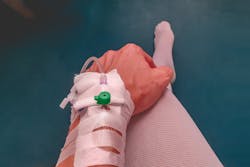A team led by researchers at the University of Cambridge analyzed data from five wards at the university's Addenbrooke's Hospital during a COVID-19 outbreak among patients and healthcare workers (HCWs) from March to June 2020. The team applied a new network reconstruction algorithm to infer patterns of virus spread among patients and HCWs, according to a news report from the Center for Infectious Disease Research and Policy (CIDRAP) at the University of Minnesota.
Of 38 transmission events studied, 20 were patient-to-patient, eight were from patient to HCW, eight were HCW to HCW, and 2 were HCW to patient. "These results suggest that patients were significantly more likely to be infected by other patients than by healthcare workers," the study authors wrote. "By contrast, HCWs were at approximately equal risk of being infected by patients and other HCWs."
In addition, 21% of patients were "superspreaders" and caused 80% of the infections, a result that the authors said was similar to that reported among the general population. In one ward, for example, two patients were the sources of four and five secondary COVID-19 infections, respectively.
Five people, including four patients and one HCW, infected at least three other people. All four patients had suspected hospital-acquired COVID-19 and significant underlying illnesses, including chronic liver disease and blood cancer, the latter of which one person was receiving immunosuppressive therapy for. Immunosuppression has been tied to prolonged viral shedding. Viral loads were similar among superspreaders and others in the study.

